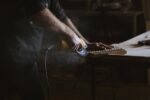How to dye wood

Dyeing wood is a great way to add some color and life to an otherwise dull piece of furniture. It’s also a fairly simple process, provided you have the right supplies on hand. In this article, we’ll show you how to dye wood using both water-based and oil-based dyes. We’ll also give you some tips on how to get the best results. Let’s get started!
Water-based dyes are the easiest to use, and they’re also the most forgiving. If you make a mistake, you can simply wipe the dye off with a damp cloth and start over. Oil-based dyes are more permanent, but they can be tricky to work with. Make sure you read the instructions on your particular brand of dye before getting started.
To dye wood using a water-based dye, start by sanding the piece of wood that you’ll be working with. This will help the dye to adhere evenly. Next, mix your chosen dye with some water according to the manufacturer’s instructions.
Apply the dye to the wood using a sponge or a brush, working in long strokes in one direction. Once the dye is evenly applied, allow it to sit for the amount of time recommended by the manufacturer.
After the dye has had a chance to set, you can apply a sealer if you like. This will help to protect the color and make it last longer. Simply brush on a thin layer of sealant and allow it to dry completely.
Oil-based dyes are more difficult to work with, but they’re also more permanent. Start by mixing the dye according to the manufacturer’s instructions. Then, apply it to the wood using a clean cloth. Work in long strokes in one direction until the entire surface is covered.
Allow the dye to sit for the amount of time recommended by the manufacturer. Once the dye has set, you can apply a sealer if desired.
That’s all there is to it! With a little time and effort, you can easily add some color to your woodworking projects using dyes. Just be sure to read the instructions on your chosen product carefully before getting started.
What types of wood can be dyed
When it comes to dyeing wood, there are a few things you need to keep in mind. The first is that not all types of wood can be dyed. The second is that even if the type of wood you’re using can be dyed, there are still some colors that will work better than others. In this blog post, we’ll go over both of those topics so you’ll know exactly what to do when it comes time to dye your own pieces of wood.
The most important thing to remember when it comes to dyeing wood is that not all types of wood can be dyed. The reason for this is because some woods are simply too porous and will absorb too much of the dye, resulting in an uneven color. Other woods are too dense and won’t absorb any of the dye at all. For these reasons, it’s important to only attempt to dye woods that are known to take well to color. Some of the most popular options include oak, maple, cherry, and walnut. If you’re not sure whether or not the type of wood you’re using can be dyed, it’s always best to err on the side of caution and consult with a professional before proceeding.
Once you’ve determined that the wood you’re using can indeed be dyed, the next step is to decide what color you want to achieve. As we mentioned before, some woods take dye better than others. For instance, oak tends to absorb dye very well, so it’s a great choice if you’re looking for a dark, rich color. Maple, on the other hand, doesn’t absorb dye as readily, so it’s best suited for lighter colors. If you’re not sure which direction you want to go in, we suggest experimenting with a few different colors on scrap pieces of wood until you find one that you like.
Once you’ve decided on a color, the next step is to prepare your wood for dying. The first thing you’ll need to do is sand the wood down so that the surface is smooth. This will help the dye penetrate evenly and prevent any streaks or blotches from forming. Next, you’ll need to apply a pre-stain conditioner to the wood. This step is particularly important if you’re working with maple or another type of wood that doesn’t absorb stain well. The conditioner will open up the pores of the wood and help the stain adhere better.
Once your wood is prepared, it’s time to start applying the dye. We recommend using a brush for this step so that you can control how much dye is being applied. Start by brushing a generous amount of dye onto the wood and then wiping away any excess with a clean cloth. It’s important to work in small sections so that the dye doesn’t have a chance to dry before you’re able to wipe it away. Once you’ve finished dying the wood, allow it to dry completely before moving on to the next step.
The final step is to apply a clear finish to the wood. This will protect the color from fading and help keep the wood looking its best for years to come. We recommend using a water-based polyurethane for this step because it’s easy to apply and dries quickly. Just be sure to read the labels carefully and follow the manufacturer’s instructions so that you don’t end up with a sticky mess.
And that’s all there is to dyeing wood! With these tips in mind, you’ll be able to achieve beautiful, professional-looking results that will last for years. So go ahead and experiment with different colors and techniques until you find a look that you love. And don’t forget to enjoy the process – after all, woodworking is supposed to be fun!
How to prepare the wood for dying
Dyeing wood is a great way to add color and personality to any piece of furniture or home décor. It’s also a relatively easy project that anyone can do with the right supplies and instructions. In this post, we will show you how to prepare the wood for dying, as well as how to apply the dye. Let’s get started!
The first step is to sand the wood. This will help create a smooth surface for the dye to adhere to. If the wood is already sanded, you can skip this step. Next, clean the wood with a damp cloth to remove any dust or debris.
Once the wood is prepped, it’s time to apply the dye. We recommend using a foam brush for this task. Dip the brush into the dye and then apply it to the wood in even strokes. Be sure to cover all of the surfaces that you want dyed.
After the wood is evenly coated with dye, let it sit for about 30 minutes before wiping off any excess with a clean cloth. Once the excess dye is removed, you can seal the wood with a clear sealer to protect the color.
Now you know how to dye wood! This project is easy and fun, and it’s a great way to add some personality to your home décor. Give it a try today!
How to dye the wood
Wood dyeing can be a great way to change the look of your furniture or other wooden objects. You can use almost any color you want, and it’s a relatively easy process. In this post, I will show you how to dye wood using two different methods.
The first method is to use an oil-based dye. This is the most common type of wood dye, and it’s very easy to use. Simply apply the dye to the wood using a brush or rag, and then wipe off any excess. Oil-based dyes will penetrate the wood, so you don’t need to worry about them rubbing off.
The second method is to use a water-based dye. These dyes are less common, but they have some advantages over oil-based dyes. They’re easier to apply, and they don’t require any wiping off of excess dye. However, water-based dyes don’t penetrate the wood as well, so they may rub off over time.
So, which method should you use? It really depends on your project. If you want the dye to last a long time, then go with an oil-based dye. If you’re looking for an easy application, then go with a water-based dye.
The different methods of applying dye to the wood
One of the most popular ways to change the color of wood is by using a dye. Unlike paint, dye penetrates the wood grain and leaves a natural looking finish. Dye can be applied in several different ways, depending on the desired effect.
The first method is to brush the dye onto the surface of the wood. This is best for small projects or for touching up areas that have faded over time. It’s also a good option if you want to create a distressed look, since the uneven application will add to the overall effect.
Another option is to apply the dye with a rag. This gives you more control over the amount of color being applied and allows you to work the dye into the grain of the wood for a more even finish.
If you want to achieve an even, uniform color, your best bet is to use a sprayer. This method allows you to apply an even coat of dye and get into all the nooks and crannies of the wood. Just be sure to wear protective clothing and work in a well-ventilated area when using a sprayer.
Once you’ve chosen your application method, it’s time to start applying the dye. Make sure to work in a well-ventilated area and follow the manufacturer’s instructions for best results. Apply the dye evenly, working in small sections until the entire piece is covered. Allow the dye to dry completely before moving on to the next step.
If you’re happy with the color, you can move on to the finishing process. If you want to darken the wood or add additional layers of color, repeat the dyeing process until you achieve the desired results. Once you’re satisfied with the color, finish the wood with a clear sealer to protect the dye and add a glossy sheen.
With a little time and effort, you can easily change the color of your wood furniture or décor using dye. Experiment with different application methods and colors to create unique looks that will add personality to your home.
Things to avoid when dyeing wood
When it comes to dyeing wood, there are a few things you want to avoid in order to ensure the best results. First of all, you never want to use bleach when dyeing wood. Bleach will strip the wood of its natural color and leave it looking dull and lifeless. In addition, you want to avoid using any harsh chemicals or abrasives when cleaning the wood before you dye it. These can damage the wood and cause the dye to not adhere properly. Finally, make sure you follow the instructions on the dye carefully. Using too much or too little dye can ruin your project. With these tips in mind, you should be able to successfully dye wood and achieve the results you desire!
How to troubleshoot common problems with dyeing wood
Wood dyeing can be a fun and rewarding way to change the look of your wood projects. However, like any other creative endeavor, it can also be frustrating if things don’t go as planned. In this post, we’ll discuss some of the most common problems people experience when dyeing wood, and we’ll provide solutions for how to fix them.
Problem: The dye is not taking to the wood.
Solution: The most common reason for this problem is that the wood is not properly prepared. Make sure that you sand the wood thoroughly before applying the dye. If the wood is still not accepting the dye, you may need to use a pre-stain conditioner or a primer designed for use with dye stains.
Problem: The color is not evenly distributed.
Solution: This problem is usually caused by one of two things: either the wood was not sanded evenly before applying the dye, or the dye was applied too heavily in some areas and not enough in others. To fix this problem, sand the wood again until it is completely smooth, then apply a second coat of dye, making sure to evenly distribute the color this time.
Problem: The color is too light.
Solution: This problem is often caused by using a water-based dye instead of an oil-based one. Water-based dyes tend to produce lighter colors than oil-based dyes. If you want a darker color, try using an oil-based dye next time. You can also try applying a second coat of dye.
Problem: The color is blotchy or uneven.
Solution: There are a few possible causes for this problem. First, make sure that you are using the right type of wood for the project. Some woods, such as pine, are more prone to blotching than others. Second, check to see if the wood was properly sanded before applying the dye. If it wasn’t, sand it again and try reapplying the dye. Finally, make sure that you are using an even coat of dye. Applying too much dye in one area can cause blotching.
With these solutions in mind, you should be able to fix any problems you experience when dyeing wood. Just remember to take your time and be patient, and the results will be worth it!
The benefits and drawbacks of dying wood
When it comes to woodworking, there are many different ways that you can finish your project. One popular option is to dye the wood. This can give your project a unique look and feel, and it’s a process that has both benefits and drawbacks. In this blog post, we will take a closer look at the pros and cons of dying wood.
Benefits of Dying Wood
There are several benefits that come with dying wood. First, it can help to protect the wood from moisture and other elements. This is especially important if you plan on using the wood outdoors or in a damp environment.
Dying also makes the grain of the wood more visible. This can give your project a beautiful and natural look. Additionally, dying can also help to fill in any cracks or imperfections in the wood.
Drawbacks of Dying Wood
While there are many benefits to dying wood, there are also some drawbacks. One of the biggest is that it can be difficult to achieve an even color. If you’re not careful, you may end up with blotches or streaks in your finished project.
Another drawback is that dying wood can be a messy process. It’s important to wear gloves and old clothes when you’re working with dye, as it can stain your hands and clothing.
Finally, dyed wood may not be as strong as untreated wood. This is because the dye can penetrate the grain of the wood and weaken it. If you plan on using the wood for a structural element in your project, it’s important to keep this in mind.
Despite the drawbacks, dying wood can be a great way to finish your project. It’s important to weigh the pros and cons before you decide if it’s right for you.
How to dye wood
Overall, dying wood is a fairly simple process that can be done at home with little to no experience. The key is to choose the right type of dye for the project, and to follow the instructions carefully. With a little bit of effort, anyone can achieve professional-looking results.






